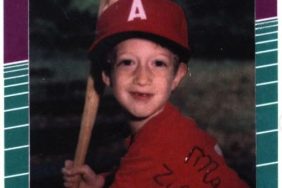Kurt Russell has been making movies for over 50 years, and here’s learned a thing or two. So when he talks, you listen, and you listen well, because this man has co-starred with Elvis, played Elvis, escaped from New York and stirred up some very big trouble in Little China.
In 2015, Kurt Russell co-starred in two of the most acclaimed westerns in years: the horrific Bone Tomahawk, and the provocative The Hateful Eight. The latter film reunited Russell with his Death Proof director Quentin Tarantino, who in his new film forces a group of uncouth men in the same room in the middle of a blizzard, and lets their prejudices build to a violent crescendo. Russell plays John Ruth, “The Hangman,” a bounty hunter who is bringing the murderer Daisy Domergue (Jennifer Jason Leigh) to justice. They spend most of the movie chained together, and that’s a tough gig for any actor.
Related: Interview | ‘Hateful Eight’ Star Tim Roth on Old Tarantino vs. New Tarantino
I sat down with Kurt Russell before Christmas to talk about his latest westerns, whether John Ruth is really as hateful as we’re led to believe, and how he fostered a working relationship with Jennifer Jason Leigh under such uncomfortable conditions. We also discussed epic mustaches and the news that Dwayne Johnson would be taking over Russell’s lead role in the Big Trouble in Little China remake… a situation that Russell himself understands from experience.
The Hateful Eight is now playing in theaters.

Walt Disney
Crave: Are you still the strongest man in the world?
Kurt Russell: Absolutely! Doing the best I can. [Laughs.]
So this is an interesting year for you and loquacious westerns…
Yeah, I know.
Was that a total coincidence or did you gravitate towards them?
Total coincidence. What happened was, years ago… I don’t know, two, three years ago… I wasn’t doing [films] much. I was more interesting in making wine. I was really in the vineyard a lot, very serious about it, having a great time learning something brand new that I really, really care about. And then I was having really good results with it so I started selling it, and it was like, yeah, I really like this business. The business is different but I love making the wine. And it was harder and harder and harder to get me out of the vineyard. I wasn’t really that interested. I read things, okay, I did a couple of things.
“I couldn’t look, in ‘Bone Tomahawk,’ the way I wanted to.”
And then I read the script Bone Tomahawk which I really liked a lot. I thought it was a really well-written western. It had a sense of authenticity to it. And with some of the violence that was in it, I thought, if shown correctly and created graphically, this had an opportunity to be a movie you probably wouldn’t get to make. You probably wouldn’t get to see it, you probably wouldn’t get to make it, because it’s low-key, authentic and then it has extreme violence. It was one of those things that was cast dependent, you know? And I very much wanted to do it with Richard Jenkins. Oh, then they other guys could do [it], then they fell out, then this guy fell out, then Richard couldn’t make it, then “I don’t want to do it without Richard.” “I’m unavailable now.” “No I’m unavailable now.” “Listen…”

RLJ Entertainment
Finally it can be done, we can make it in 20 days right here in Los Angeles, and it’s a labor of love. It’s the director’s first time. And we get to make the movie. I finished on Saturday morning, as time would have it, as luck would have it. I finished on Saturday morning at 11 o’clock, I started rehearsals for The Hateful Eight Monday morning at eight, and I had about six weeks rehearsal time before we started shooting the movie.
So… I had to start growing my mustache. I couldn’t look, in Bone Tomahawk, the way I wanted to. I wanted to have more of a… the way it was written it was like maybe turn of the century, just before the turn of the century. There’s probably cars, there’s probably automobiles. This place is too far out [to have them]. We don’t know when it is, exactly. I thought well, okay, I’ll cheat it. I’ll get halfway, I’ll go to a halfway house look. I’ll have more of a beard for Bone Tomahawk, and then I’ll have less of a beard and more of a mustache, grow it out, for [The Hateful Eight].
Because this guy [gestures to face] has a big walrus mustache. That was established. You know, when you see John Ruth you see what you get. I mean, you see him… this is coming your way. This force is coming your way, and he’s uncouth, bombastic and paranoid as hell.

The Weinstein Company
Is he hateful?
I never thought so.
That’s the thing. It’s The Hateful Eight, and there are more than eight characters. Did you ask yourselves, “Which of us are The Hateful Eight?”
My question always was… well, my feeling was that everybody probably felt the same way about their own character. I had no question that the most hateful person, to me, the most hateful person was Major Warren [Samuel L. Jackson]. The next most hateful was The General [Bruce Dern]. The next hateful was Daisy [Jennifer Jason Leigh]. And that almost goes, like, that mixes race, gender and politics.
“By this time they’re husband and wife. There’s John Ruth, there’s Daisy Domergue, and then there’s Ruth & Domergue.”
I always felt John Ruth was completely appreciative of the cornerstone of American existence, which is: you’re going to get your day in court. You’re going to get your day in court. He could shoot them in the back. We talk about that. “Shoot them in the back.” He doesn’t do that. He brings you in so you can hang. No matter what you did or how bad, you get your day in court.
So a guy’s going to take the chance of risking his own life to do that. It has made him hateful. He hates the fact that people won’t adhere to that, that they don’t get that, that they’ll try to take advantage of that. [He] will hate the fact that they do these criminal things. He hates what she does. However, he’s chained to them half the time and he’s gotten to know them. They have a human side, all of them!
And in this case it’s a woman who he’s been chained to for a week, and I think there’s a thing there. There is a thing.

The Weinstein Company
There are moments when you’re sharing food…
They’re a husband and wife. By this time they’re husband and wife. There’s John Ruth, there’s Daisy Domergue, and then there’s Ruth & Domergue. There’s three things going on there.
What do you talk about with Jennifer Jason Leigh while you’re chained together all day?
The first month, not anything. We didn’t talk. Not much. We rehearsed. She was great. Our rhythms were identical. The only thing that I was concerned with was, for her to be free to create the character she needed to create for herself and the movie, she had to feel safe with me. And there’s a lot of physical activity. There are a lot of punches, and there are a lot of difficult ones. There’s a lot of movement that looks simple but is not. I knew that once she felt safe with me then I could do anything I wanted and she could do anything she wanted.
“I said to her, ‘Don’t worry. We may do this 20 times, but I can tell you one thing that’s not going to happen: you’re not going to get hit.'”
How do you foster that relationship? Just time?
I do this. [Mimes hitting with an elbow.] I say “Let’s do this a couple of times.” Boom. She’d take that hit. Boom! She’d take that hit. I do that ten times, boom, and I said to her, “Don’t worry. We may do this 20 times, but I can tell you one thing that’s not going to happen: you’re not going to get hit.” In a very short period of time, [moreso] than any other actor I’ve ever worked with, she went, “He’s never going to hit me.”
And I felt her just [relax]. She just felt completely comfortable, and she started to open up and do her thing. She knew I could do anything I wanted, because if I was going to hit her, all she had to do was bam, take it. “He just decided to hit me right now.” Because we had the kind of freedom as actors. I might do anything. But what it did was, because I was John Ruth, she began to really understand John Ruth and she began to be able to be Daisy Domergue and drive him a little bit crazy, because she knows she’s smart. She knows what he can take and what he can’t take. She was laughing in his face with that bowl of stew.
That’s a tough gag because I’m not looking at her when I throw that bowl of stew at her, so we did that like twelve times and I just kept missing her and missing her and missing her, and Quentin was getting a little, “Okay, what can we do to fix it?” I said, “This is a tough gag. When it’s going to work it’s going to work. But I can tell you what’s not going to happen: that bowl is not going to hit her head. It’s going to come that far from her head one time and I’m going to get all of that stew in her face, and it will be perfect and she’ll do it perfectly. But you will not be able to watch this thing the second time around, you won’t see her doing this [mimes flinching], ever.”
And that was the relationship that had to happen. That had to happen.

The Weinstein Company
You’ve been doing this a while. You’ve learned these lessons the hard way, I imagine. Where does something like that come from, learning you just have to get the right take? Was there a moment on another film…?
Just be patient. You have to be patient because the only thing that matters is the one take that works. Guess what? We can do it 50 times. You want to know something? 49 takes will never be seen by other people, ever. Ever, ever, ever. It’s been brushed away. It’s burnt. It’s gone. The audience only sees that one, and in everybody’s mind [that’s what happened].
Bogart never said, “Here’s looking at you kid!” Never! It never happened! It never ever happened. He may have done 40 takes where he said “Here’s looking at you kid!” […] But the one take that was used was, “Here’s looking at you, kid.” Boom, done, history. That’s the truth on every single take in every movie you ever make.
So you never know which one’s going to be the one, so you always have to make it like it’s the first time, and when it’s physical activity mixed with it and somebody’s going to have to throw a punch or throw a bowl of stew or whatever it is, you’ve got chains attached to you that can fly and bust somebody, chip somebody’s tooth…
This stuff seems very small. It’s not because the actor who’s going to get it, it stops them from behaving the way they want to behave.

The Weinstein Company
I’m thinking now of Big Trouble in Little China and all the outtakes I want to see now, of “Jack Burton says… WHAT THE HELL!”
Yeah.
Does a character ever get found entirely that way?
It can happen. It can happen but it’s extremely rare. You could probably do it with Brando. You could probably take outtakes from Brando that would just make The Godfather a flaming queen. He may have played him [that way] in a couple of takes, who knows, because he was that free to go in whatever direction he wanted to go to find something. It depends on how the director puts it together, right?
“You have to be patient because the only thing that matters is the one take that works.”
So that can happen but most of the time you’re in the zone. We did it a lot on this movie. We played up, down, sideways, rehearse it, rehearse it, rehearse it a bunch of times. Go on the set, three weeks later and shoot it completely different.
I feel like people have this idea that because Quentin Tarantino’s dialogue is so specific and so recognizable, that it’s got to be really rigid. You say it just one way.
Quentin’s dialogue… first of all, he writes certain things for certain people. In this case when it came to Sam Jackson’s character or my character, he had us in mind. He was hearing our voices. So he was writing already to a strength that that actor has. He does it on purpose. So when I read it I know what he’s trying to do. Once in a while I don’t, I say, “What is this? Say this for me… Oh, okay! Great.”

The Weinstein Company
Like what?
Like… [Thinks.] On the page it looks like one thing, on another page it’s another. Like, one day Michael Madsen couldn’t be there so I was doing, off-stage, I was doing his character. And the character had to say, this is Michael’s character, “If we couldn’t get John Ruth there [we’ll] get Daisy there to do blah-blah.” And I do this three or four times and he’s just like, “I can’t hear you. I can’t hear you say this one more time the way you’re saying it.”
I say, “What am I doing wrong?” He said, “You’re doing a great Michael Madsen, but the line is, ‘If we couldn’t get John Ruth here, then we get John and Daisy there.” I went, “Oh, you mean in the town!” He went “Yeah!” so I went “Oh, okay!” See, it’s things like that. Simple thing. I didn’t know that when you read that, that that’s what you were saying.
So [Tarantino’s] clarity there is very necessary. But as far as playing a line or giving a line emphasis or importance or whatever, you drop it… no, you’re playing the part. You’re finding the rhythms and his dialogue is leading you to it.
“In the dictionary under ‘shit-eating grin?’ That would be it.”
There’s a moment in Death Proof, in the extended cut that was released separately, when you’re getting the lap dance. She bends over and you’re revealed to have the shit-eatingest grin that I’ve ever seen anyone have in the world. Was that you, or was that in the script that you had the shit-eatingest grin ever?
No, there’s nothing written about the lap dance. She just gives him a lap dance.
So you just discovered that on the day?
Oh yeah, I’m just playing that guy. He’s a 55-year-old guy in the reverie of a kinda semi dumpy, kinda hot, 30-year-old girl dancing on his lap that the rest of the people are looking at going, “He thinks that’s great.” So for him it was like, “This is fucking great. It’s good enough for me, man! It’s good enough for me.” And she has no idea by the way that I’m going to kill her in about three hours. So yeah, that’s just what you’re doing.
Yeah, to me that was the epitome of… in the dictionary under “shit-eating grin?” That would be it. [Laughs.]

20th Century Fox
I’m sure you know about the Big Trouble in Little China remake.
Yeah, yeah!
Is Dwayne Johnson the right guy, do you think?
I don’t know. Here’s the thing. When I did Elvis I went through about a six month period of listening to the world, anybody that had any inclination to write anything about the upcoming Elvis biopic, they were just having a field day with Kurt Russell. Like, “Oh my fucking god. Oh my fucking god. Oh my god. You got to be kidding me. That Disney actor. That Disney guy?” They couldn’t come up with enough put downs.
And at first I kind of went, “Oh yeah? Whatever.” Then I went, “You know? Fuck them.” And then I went, “Oh, wait a minute. Bring it on, boys. Bring it on, because it really does give me nowhere to go but up.” And then I thought, “I’ll be good at this. I know that. I know I’m going to do a good job here. And at that point they owe me an apology.”
Did they apologize?
Of course not! Of course not. What they did though, was – I had a shit-eating grin on my face, I can tell you that – they did it begrudgingly. They came out and went, “Oh my god! Whoa!” but they didn’t come out and apologize, as far as I know anyway. [Laughs.]
Top Photo: Marc Piasecki / Getty Images Entertainment
William Bibbiani (everyone calls him ‘Bibbs’) is Crave’s film content editor and critic. You can hear him every week on The B-Movies Podcast and watch him on the weekly YouTube series Most Craved and What the Flick. Follow his rantings on Twitter at @WilliamBibbiani.








